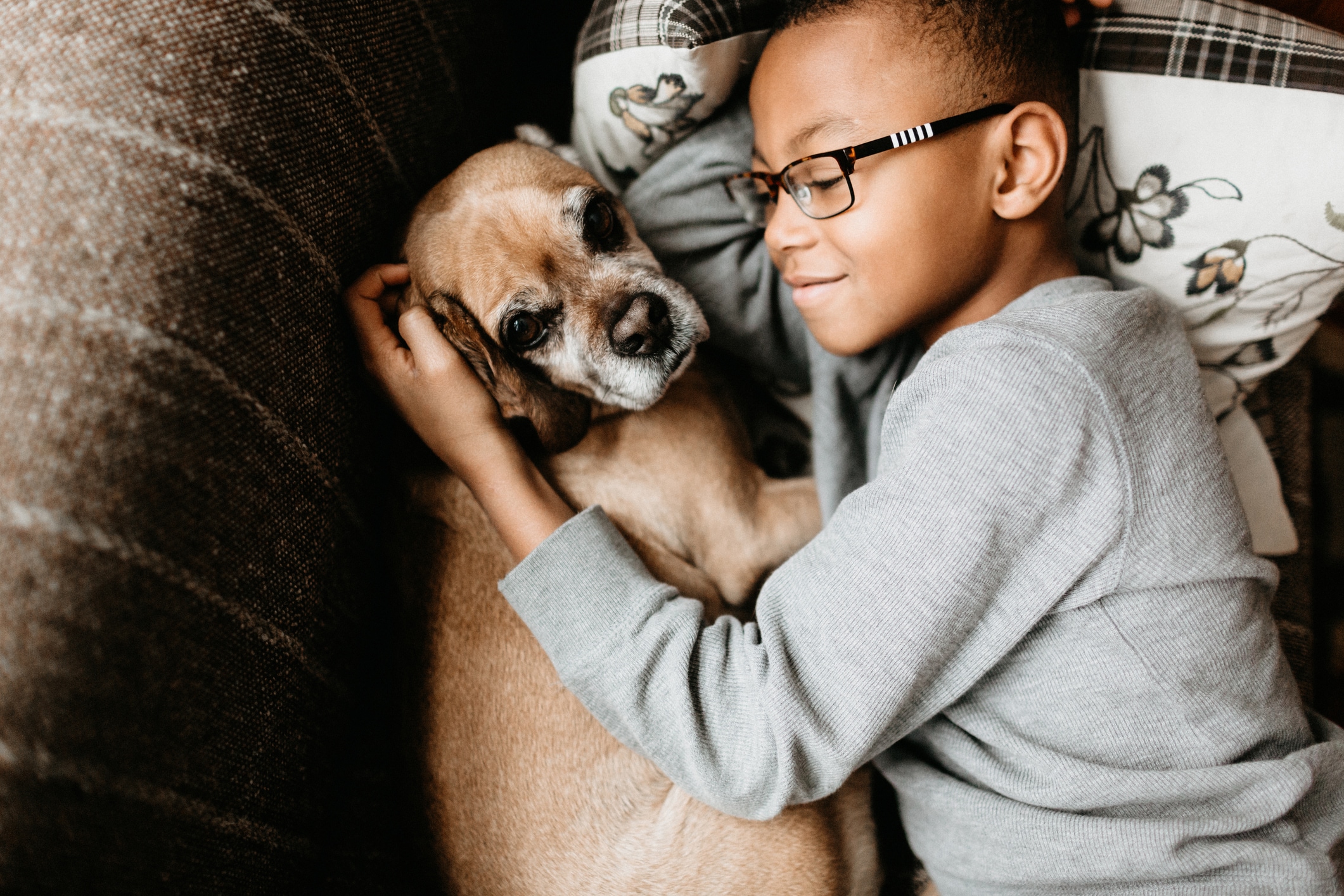Ever wonder what dogs are trying to say as they bark at one another at the park? Or if they’re capable of “talking” to each other the way we might with a friend over coffee? While a reliable dog-to-human translation device has yet to be created, there are ways you can deduce what your dog is “saying” if you pay enough attention.
“Dogs are communicating all the time,” says Allie Bender, certified dog behavior consultant and founder and co-owner of Pet Harmony Animal Behavior and Training. “They typically communicate via body language and occasionally verbally (via growling, barking, etc.).”
Bender says they communicate in other ways as well, but more on that later. First, experts weigh on whether dogs talk to each other and what exactly they’re trying to say. Read more to see what they have to say on canine communication in all its forms.
Do dogs talk to each other?
Experts agree that dogs use three main forms of communications: body language, vocalizations and scent.
Body language
“Dogs primarily communicate with one another through their body language and behavior,” says Bender. “Different body language signals can communicate different things, like play solicitation, appeasement, affiliative behavior, discomfort and asking for space.”
Colby Julien, animal behaviorist and dog trainer at Geo-Sniffing, says there are around 30 or more body cues dogs use to communicate, identified as “calming signals” by Norwegian dog trainer and canine ethologist Turid Rugaas. These signals are universal among canines, and are generally reciprocated between dogs. They’re also “used to let others know they are either not a threat or that they feel threatened,” adds Julien.
For example, says veterinarian Dr. Sarah Cortright, a high, stiff tail wag can indicate “alertness or aggression,” while a more relaxed wag generally indicates friendliness. Other canine calming signals include:
- Side-eye: Also called “whale eye.” This occurs when a dog turns its eyes sideways, revealing the whites while keeping its head still. This is a strong sign of discomfort or stress and can escalate quickly to a bite if ignored.
- Freezing: This can be done standing or laying down and is believed to have originated with hunting behavior. It may be used when a dog feels threatened, when someone is approaching or to calm down a conflict situation.
- Licking and lip smacking: If there is no food around, these signals can be a sign of unease or stress and often occur in tandem.
- Puppy pose: This looks like the dog moving downward with their front legs as though bowing. It can be an invitation to play with another dog.
- Yawning: This may be used both when the dog feels threatened (e.g. when someone is yelling), when the dog is happily anticipating something (e.g. about to go for a walk) or simply when tired.
“Ear positioning also plays a role, with forward ears signaling engagement and pinned-back ears indicating fear or submission,” says Cortright. “A dog’s posture can also communicate dominance, confidence or playfulness — all of which impact interactions with other dogs.”
“Howling is commonly used for long-distance communication, bonding or responding to specific sounds… growling can be a warning or a sign of discomfort.”
— Dr. Sarah Cortright, veterinarian
Vocalizations
Dogs rely on several forms of vocalization, including howling, barking, whining and growling, but that hasn’t always been the case. “Vocalizations like barking and whining primarily evolved for human interaction,” says Julien. “It usually means they want something, whether it’s food, praise or play.”
Indeed, scientists believe that barking evolved over time due to the domestication of dogs, as barking is rarely seen in other wild canines. That said, they might still use it when interacting with one another, such as a “warning” bark to keep another dog away or a “friendly” bark inviting another dog to play.
“Howling is commonly used for long-distance communication, bonding or responding to specific sounds,” says Cortright. “And growling can be a warning or a sign of discomfort — though in some contexts, it may also be playful.”
Scent
While dogs don’t directly communicate with one another through scent, they have an amazing sense of smell which they use to communicate in a more indirect way.
“Scent communication is mainly used for marking territory and greetings,” says Julien. You see this anytime dogs meet and spend a fair amount of time sniffing each other, or when they spend time sniffing the ground or other areas where another dog has been.
Do dogs talk to humans?
While they can’t exactly tell us what they think of their new chew toy or if we’re their favorite human, pups are still pretty great at communicating their emotions and wants to humans, similarly to how they communicate with other dogs.
“There are still things like play solicitation, appeasement, affiliative behavior, discomfort and asking for space,” says Bender. For example, dogs might bark because they want you to throw a ball, need water or because they’re experiencing anxiety. Alternatively, you might see your pup wag their tail when they’re excited to see you come home.
“Because dogs communicate primarily through body language, we are always communicating with our dogs whether or not we realize it. They’re very good at picking up on our moods, patterns and behaviors.”
— Allie Bender, dog behavior consultant and animal behavior and training business founder
But here’s another fun dog fact: “Research has shown that dogs can recognize human emotions and distinguish between happy and angry facial expressions,” says Cortright.
This means dogs will adjust their communicative behavior depending on how we are reacting. If they jump excitedly and you’re smiling, they’ll likely continue. If you look upset or turn away? Not so much.
Can dogs understand humans when they talk?
“Because dogs communicate primarily through body language, we are always communicating with our dogs whether or not we realize it,” says Bender. “They’re very good at picking up on our moods, patterns and behaviors — often too good.”
However, while dogs can generally perceive our nonverbal communication, that doesn’t always translate to them understanding our words. “We humans primarily communicate via vocalization, and so we often expect other species to communicate in the same way, and then get frustrated when that assumption is untrue,” Bender explains. “We need to keep in mind that intention and interpretation often differ because we’re different species.”
Language vs. body cues
Bender points to the example of jumping: “I often see folks trying to discourage their dog from jumping up on them by telling them ‘no’ and pushing them away. Their verbal language says ‘no,’ but their body language is engaging in what could be interpreted by their dog as a play behavior.”
This can cause a lot of confusion for both dog and human.
Consistent communication
Additionally, Bender says consistency is vital for communicating with dogs, and while we might think we’re being consistent, we aren’t always. For example, she says she’ll have clients say their dog isn’t coming to them when they’re called.
“They formally taught the behavior saying ‘come,’ but then in day-to-day life say, ‘C’mere,’ ‘c’mon,’ ‘get over here,’ etc., which are not cues that were actually taught,” says Bender. “Because dogs don’t speak our language and don’t know that those words are synonymous, we would need to teach each [word] individually or be consistent with the word we use.”
Positive reinforcement
Other ways to improve on our communication with our pups include using specific tones of voice and positive reinforcement.
“Excited, happy tones reinforce positive behaviors, while a calm, firm voice is best for commands,” says Cortright. “Dogs respond well to confident, open body language, and rewarding desired behaviors with treats, praise or play helps reinforce training.”
The final word on dog communication
So, do dogs talk to each other? In short, yes. While we can’t have lengthy conversations with them, our four-legged besties are still excellent communicators — both with us and each other.
Dogs use signals like body cues, scent and more to get their messages across. “Understanding the ways dogs communicate helps strengthen the bond between pet parents and their furry companions,” Cortright concludes. “By paying close attention to their vocalizations, body language and behaviors, we can better meet their needs and enhance our relationships with them.”





